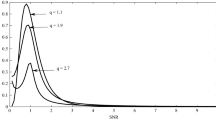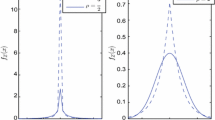Abstract
A unified approach based on truncated moment generating function (TMGF) is employed to derive the explicit expressions for channel capacity of log-normal channel under different adaptive transmission policy. The analysis is carried out assuming channel state information known to both transmitter and receiver. The efficacy of the approach is based on the fact it yields computationally convenient and efficient results in log-normal fading environment. Based on TMGF, a simple closed form expression for higher order moments of channel capacity for log-normal channels is obtained when channel state information is only known to receiver. Numerical computation in relation to simulation results for varying value of \(\sigma _{ dB}\) over permissible range are carried out to validate the accuracy of derived expressions.






Similar content being viewed by others
References
Goldsmith, A. (2006). Wireless communications. Singapore: Cambridge University Press.
Goldsmith, A., & Varaiya, P. (1997). Capacity of fading channels with channel side information. IEEE Transaction on Information Theory, 43(6), 1986–1992.
Simon, M. K., & Alouini, M. S. (2000). Digital communication over fading channels: A unified approach to performance analysis. New York: Wiley.
Lee, W. C. Y. (1990). Estimate of chanel capacity in Rayleigh fading environment. IEEE Transactions on Vehicular Technology, 93(3), 187–189.
Sagias, N. C., Tombras, G. S., & Karagiannidis, G. K. (2005). New results for the Shannon channel capcity in generalized fading channels. IEEE Communication Letters, 9(2), 97–99.
Alouni, M. S., & Goldsmith, A. J. (1999). Capacity of Rayleigh fading channels under different adaptive transmission and diversity-combining techniques. IEEE Transactions on Vehicular Technology, 48(4), 1165–1181.
Yilmaz, F., & Alouini, M. S. (2012). A unified MGF-based capacity analysis of diversity combiners over generalized fading channels. IEEE Transactions on Communications, 60(3), 862–875.
Renzo, M. D., Graziosi, F., & Santucci, F. (2010). Channel capacity over generalized fading channels: A novel MGF-based approach for performance analysis and design of wireless communication systems. IEEE Transactions on Vehicular Technology, 59(1), 127–149.
Skraparlis, D., Sakarellos, V. K., Panangopoulos, A. D., & Kanellopoulos, J. D. (2011). New results on the statistics and the capacity of dual-branch MRC and EGC diversity in correlated lognormal channels. IEEE Communication Letters, 15(6), 617–619.
Karmeshu, & Khandelwal, V. (2011). MGF and high order moment of channel capacity in log-normal fading environment. In Proceedings of the international conference on wireless technologies for humanitarian relief, ACWR 2011, ACM (pp. 99–106).
Karmeshu, & Khandelwal, V. (2013). On the applicability of average channel capacity in log-normal fading environment. Wireless Personal Communications, 68(4), 1393–1402.
Theofilakos, P., Kanatasand, A. G., & Efthymoglou, G. P. (2008). Performance of generalized selection combining receivers in K-fading channels. IEEE Communications Letters, 12(11), 816–818.
Al-Qahtani, F. S., Zummo, S. A., Gurung, A. K., & Hussain, Z. M. (2010). Spectral efficiency of maximum ratio combining (MRC) over slow fading with estimation errors. Elsevier Digital Signal Processing, 20(1), 85–96.
Laourine, A., Alouini, M. S., Affes, S., & Stephenne, A. (2008). On the capacity of generalized-K fading channels. IEEE Transactions on Wireless Communications, 7, 2441–2445.
Mallik, R. K., Win, M. Z., Shao, J. W., & Goldsmith, A. (2004). Channel capacity of adaptive transmission with maximal ratio combining in correlated Rayleigh fading. IEEE Transactions on Wireless Communications, 3, 1124–1133.
Laourine, A., Alouini, M. S., Affes, S., & Stephenne, A. (2009). On the performance analysis of composite multipath/shadowing channels using the G-distribution. IEEE Transactions on Communications, 57(4), 1162–1170.
Dwivedi, V. K., & Singh, G. (2012). Marginal moment generating function based analysis of channel capapcity over correlated Nakagami-m fading with maximal-ration combining divesity. Progress in Electromagnetics Research B, 41, 333–356.
Le, K. N., & Dabke, K. P. (2012). Channel capacity of OFDM systems employing diversity in fading environments. Wireless Communications and Mobile Computing, 12(17), 1493–1516.
Molisch, A. F., Foerster, J. R., & Pendergrass, M. (2003). Channel models for ultrawideband personal area networks. IEEE Wireless Communication Magazine, 10(6), 14–21.
Cotton, S. L., & Scanlon, W. G. (2007). Higher order statistics for lognormal small-scale fading in mobile radio channels. IEEE Antennas and Wireless Propagation Letters, 6, 540–543.
Foerster, J., et al. (2003). Channel modelling sub-committee report final. IEEE P802.15 wireless personal area networks. Technical Report P802.15-02/490r1-SG3a.
Gaofeng, P., Ekici, E., & Feng, Q. (2012). Capacity analysis of log-normal channels under various adaptive transmission schemes. IEEE Communications Letters, 16(3), 346–348.
Laourine, A., Stephenne, A., & Affes, S. (2007). Estimating the ergodic capacity of log-normal channels. IEEE Communication Letters, 11(7), 568–570.
Laourine, A., Stephenne, A., & Affes, S. (2009). On the capacity of log-normal fading channels. IEEE Transaction on Communications, 57(6), 1603–1607.
Heliot, F., Chu, X., Hoshyar, R., & Tafazolli, R. (2009). A tight closed-form approximation of the log-normal fading channel capacity. IEEE Transaction on Wireless Communications, 8(6), 2842–2847.
Gradshteyn, I. S., & Ryzhik, I. M. (2000). Table of integrals, series, and products (6th ed.). San Diego, CA: Academic Press.
Abramowitz, M., & Stegun, I. A. (1970). Handbook of mathematical functions with formulas, graphs, and mathematical tables. New York: Dover Publications.
Author information
Authors and Affiliations
Corresponding author
Rights and permissions
About this article
Cite this article
Khandelwal, V., Karmeshu Channel Capacity Analysis over Slow Fading Environment: Unified Truncated Moment Generating Function Approach. Wireless Pers Commun 82, 2377–2390 (2015). https://doi.org/10.1007/s11277-015-2353-y
Published:
Issue Date:
DOI: https://doi.org/10.1007/s11277-015-2353-y




